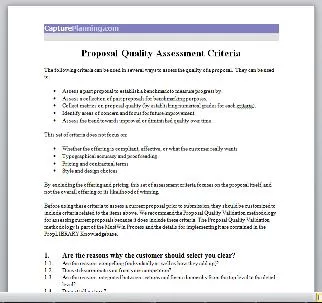Articles
-
 People spend too much time thinking about what to say about themselves in their proposals and too little time imagining what it must be like as the customer reading what you are submitting. Most people wouldn’t even accept their own proposal if it came from another vendor and it was their decision. Here are 30 reactions the customer might have to your proposal that could result in your losing. Do I know you? Have we ever talked? All they have to say is that they have experience. I
People spend too much time thinking about what to say about themselves in their proposals and too little time imagining what it must be like as the customer reading what you are submitting. Most people wouldn’t even accept their own proposal if it came from another vendor and it was their decision. Here are 30 reactions the customer might have to your proposal that could result in your losing. Do I know you? Have we ever talked? All they have to say is that they have experience. I- 0 comments
- 5,917 views
-
 Growth is the source of all opportunity for a contractor. Prices are locked in for the duration of the contract. Even when you account for pricing escalations, that usually just covers inflation, and not promotions, new hires, new tools, etc. Without growth, most contractors can’t even tread water for very long. Without growth, rising costs will force them to cut overhead expenses. Investing for the future almost always comes from growth. Everybody in the company benefits from its growth
Growth is the source of all opportunity for a contractor. Prices are locked in for the duration of the contract. Even when you account for pricing escalations, that usually just covers inflation, and not promotions, new hires, new tools, etc. Without growth, most contractors can’t even tread water for very long. Without growth, rising costs will force them to cut overhead expenses. Investing for the future almost always comes from growth. Everybody in the company benefits from its growth- 0 comments
- 1,786 views
-
 Most companies assign whoever’s available to the role of proposal manager. Often it’s the future project manager, someone with a technical writing or editorial background, or an ambitious administrative assistant. Excellent proposal managers can come from these and other backgrounds. But so can failures. We’ve identified seven key things to look for when selecting someone to manage a proposal effort. It’s worth noting that experience with the customer and technical experience with the offer
Most companies assign whoever’s available to the role of proposal manager. Often it’s the future project manager, someone with a technical writing or editorial background, or an ambitious administrative assistant. Excellent proposal managers can come from these and other backgrounds. But so can failures. We’ve identified seven key things to look for when selecting someone to manage a proposal effort. It’s worth noting that experience with the customer and technical experience with the offer- 0 comments
- 11,933 views
-
 If you need to write a winning proposal to close the sale, then the pre-RFP pursuit phase isn’t just about lead identification. The pre-RFP pursuit phase becomes about preparing to win the proposal. People can’t achieve the goal if they don’t know what it is. If you have more than one, they need to be prioritized. Qualify the lead. Does it fulfill for the company’s lead qualification criteria? Discover what it will take to win. Can you articulate what it will take to win? How
If you need to write a winning proposal to close the sale, then the pre-RFP pursuit phase isn’t just about lead identification. The pre-RFP pursuit phase becomes about preparing to win the proposal. People can’t achieve the goal if they don’t know what it is. If you have more than one, they need to be prioritized. Qualify the lead. Does it fulfill for the company’s lead qualification criteria? Discover what it will take to win. Can you articulate what it will take to win? How- 0 comments
- 377 views
-
 Imagine the customer finding a web page providing insight into the issues they face in getting what they want. What would it look like? What would they do with the information? Below are a series of topics that a potential customer would find very helpful if you published the answers. Take a look at this list as you consider what the customer needs to know to write an RFP that results in them getting what they need: Ways that we can work together that don’t require an RFP How much
Imagine the customer finding a web page providing insight into the issues they face in getting what they want. What would it look like? What would they do with the information? Below are a series of topics that a potential customer would find very helpful if you published the answers. Take a look at this list as you consider what the customer needs to know to write an RFP that results in them getting what they need: Ways that we can work together that don’t require an RFP How much- 0 comments
- 8,060 views
-
 Since we know that only the customer can decide what a winning proposal is, to increase our win probability we need to be able to guess what the customer will decide. To do that, we need to know what the customer: Needs Expects Finds compelling Can afford You also need to know how they make decisions, what tradeoffs they prefer, and how they evaluate the proposals that they receive. If they formally evaluate and score the proposals they receive, you need to know
Since we know that only the customer can decide what a winning proposal is, to increase our win probability we need to be able to guess what the customer will decide. To do that, we need to know what the customer: Needs Expects Finds compelling Can afford You also need to know how they make decisions, what tradeoffs they prefer, and how they evaluate the proposals that they receive. If they formally evaluate and score the proposals they receive, you need to know- 0 comments
- 6,558 views
-
 A lot of companies do exactly the wrong thing when faced with a must win opportunity. They try to make sure they don’t lose. They give the customer exactly what they ask for in the RFP. They may even make improvements here or there, if they can do it within the boundaries of the instructions. They try to be exactly what the RFP says the customer wants. They never realize that they are setting themselves up to lose. When your goal is to write a good proposal, here is what you get: Me
A lot of companies do exactly the wrong thing when faced with a must win opportunity. They try to make sure they don’t lose. They give the customer exactly what they ask for in the RFP. They may even make improvements here or there, if they can do it within the boundaries of the instructions. They try to be exactly what the RFP says the customer wants. They never realize that they are setting themselves up to lose. When your goal is to write a good proposal, here is what you get: Me- 0 comments
- 13,659 views
-
 Proposals really aren’t about management. Managers operate defined processes with resources and tools to achieve a defined outcome. Proposals are about adapting against a deadline and figuring things out. Proposals require leaders. If you hand me a document and ask me to format it according the RFP specifications and give me sufficient resources and time, I can manage that. But if you hand me an RFP with structural and interpretation problems and tell me to figure out how to create somethi
Proposals really aren’t about management. Managers operate defined processes with resources and tools to achieve a defined outcome. Proposals are about adapting against a deadline and figuring things out. Proposals require leaders. If you hand me a document and ask me to format it according the RFP specifications and give me sufficient resources and time, I can manage that. But if you hand me an RFP with structural and interpretation problems and tell me to figure out how to create somethi- 0 comments
- 4,485 views
-
 When people use the term proposal manager they often mean different things. When people use the title proposal manager they often give it to staff with varying capabilities. And even more variation in the level of authority. What one company expects from a proposal manager can be very different from what another company expects. When people think of a proposal manager as the person ultimately responsible for delivering the proposal, they sometimes make the mistake of rolling up all the poss
When people use the term proposal manager they often mean different things. When people use the title proposal manager they often give it to staff with varying capabilities. And even more variation in the level of authority. What one company expects from a proposal manager can be very different from what another company expects. When people think of a proposal manager as the person ultimately responsible for delivering the proposal, they sometimes make the mistake of rolling up all the poss- 0 comments
- 8,313 views
-
 The problem with planning a Black Hat review is understanding what people’s expectations are. Everyone defines it differently. I’ve never seen two practiced the same way. The very name tells you nothing about its scope. But it does sound cool, and everyone wants to have one. So let me start off with a definition: A Black Hat review is a (preferably pre-proposal) competitive assessment. But that doesn’t tell you what should go into it or how it should be conducted. Learn what your
The problem with planning a Black Hat review is understanding what people’s expectations are. Everyone defines it differently. I’ve never seen two practiced the same way. The very name tells you nothing about its scope. But it does sound cool, and everyone wants to have one. So let me start off with a definition: A Black Hat review is a (preferably pre-proposal) competitive assessment. But that doesn’t tell you what should go into it or how it should be conducted. Learn what your- 0 comments
- 480 views
-
 Marketing is often poorly defined. What one company calls “marketing” can be very different from another company. Business development is often poorly defined. What one company calls “business development” can be very different from another company. This makes comparing them fun. They overlap so much that some companies don't really do marketing. And that makes understanding the comparison important. What is marketing? What is business development? Marketing is what
Marketing is often poorly defined. What one company calls “marketing” can be very different from another company. Business development is often poorly defined. What one company calls “business development” can be very different from another company. This makes comparing them fun. They overlap so much that some companies don't really do marketing. And that makes understanding the comparison important. What is marketing? What is business development? Marketing is what- 0 comments
- 1,451 views
-
 If you are treating winning business as an expense, you may be leaving money on the table. Here are some signs that you may have fallen into this trap and recommendations for what to do about it: Are you closing the leads you have? If you are not winning enough of what you pursue, either you are pursuing the wrong leads or you are not pursuing them effectively. If you’re not winning the majority of your pursuits, you are probably leaving money on the table. If you are winning enough to
If you are treating winning business as an expense, you may be leaving money on the table. Here are some signs that you may have fallen into this trap and recommendations for what to do about it: Are you closing the leads you have? If you are not winning enough of what you pursue, either you are pursuing the wrong leads or you are not pursuing them effectively. If you’re not winning the majority of your pursuits, you are probably leaving money on the table. If you are winning enough to- 0 comments
- 1,384 views
-
 I was recently asked about what’s changed in the proposal industry over my career. My response was that what strikes me far more is how little has changed. It’s not just that we have the same problems we had decades ago, it’s that there are viable solutions just waiting to be implemented. Every other part of the companies that depend on winning proposals for their revenue have developed and matured their practices. Except the proposal function. Please read the following as motivation and f
I was recently asked about what’s changed in the proposal industry over my career. My response was that what strikes me far more is how little has changed. It’s not just that we have the same problems we had decades ago, it’s that there are viable solutions just waiting to be implemented. Every other part of the companies that depend on winning proposals for their revenue have developed and matured their practices. Except the proposal function. Please read the following as motivation and f- 0 comments
- 1,689 views
-
 It may seem a bit counterintuitive, but streamlining your proposal management process starts by writing down your proposal quality criteria. In fact, it’s the quickest and easiest way to launch your process. It works better than starting at the kickoff meeting and trying to chart the steps. Just simply having proposal quality criteria gives you a way to: Provide guidance to your proposal writers Enable reviewers to validate the quality of what your writers produce I
It may seem a bit counterintuitive, but streamlining your proposal management process starts by writing down your proposal quality criteria. In fact, it’s the quickest and easiest way to launch your process. It works better than starting at the kickoff meeting and trying to chart the steps. Just simply having proposal quality criteria gives you a way to: Provide guidance to your proposal writers Enable reviewers to validate the quality of what your writers produce I- 0 comments
- 412 views
-
 A great way to fill your pipeline is through divide and conquer. It's easier to eat the pie one slice at a time. Don't think of the total number of leads you need to find to hit your numbers. Instead, think of how many leads you need in each slice. Then strategically consider how big each slice should be. Is one dominant? Should you avoid having all of your eggs in one basket? Which ones are required to maintain your revenue, and which are the targets for growth? Here are some ideas for how to d
A great way to fill your pipeline is through divide and conquer. It's easier to eat the pie one slice at a time. Don't think of the total number of leads you need to find to hit your numbers. Instead, think of how many leads you need in each slice. Then strategically consider how big each slice should be. Is one dominant? Should you avoid having all of your eggs in one basket? Which ones are required to maintain your revenue, and which are the targets for growth? Here are some ideas for how to d- 0 comments
- 2,118 views
-
 Differentiation is vital. And yet, sometimes people really struggle to find differentiators. For example, when the RFP tells you exactly what to bid, how many to bid, how to structure your pricing, and what the terms and conditions must be, it seems like there isn’t a lot of room to differentiate your offering. But the truth is, you’re just not trying hard enough. You can always differentiate. Here are four approaches to differentiation you can consider when you're struggling: Differenti
Differentiation is vital. And yet, sometimes people really struggle to find differentiators. For example, when the RFP tells you exactly what to bid, how many to bid, how to structure your pricing, and what the terms and conditions must be, it seems like there isn’t a lot of room to differentiate your offering. But the truth is, you’re just not trying hard enough. You can always differentiate. Here are four approaches to differentiation you can consider when you're struggling: Differenti- 0 comments
- 13,284 views
-
 Even when you can’t think of any differentiators, you can still show insight. And if you can’t do that, all you have left is to win based on a lower price. If you have no insight and your competitors do, maybe you shouldn’t bid. What is insight and why does it matter in proposals? Insights are the realizations you have that show the customer you not only have a deeper understanding than your competitors, but that you know how to deliver better results. Your insights can lead to a b
Even when you can’t think of any differentiators, you can still show insight. And if you can’t do that, all you have left is to win based on a lower price. If you have no insight and your competitors do, maybe you shouldn’t bid. What is insight and why does it matter in proposals? Insights are the realizations you have that show the customer you not only have a deeper understanding than your competitors, but that you know how to deliver better results. Your insights can lead to a b- 0 comments
- 3,003 views
-
 This document provides a set of criteria can be used in several ways to assess the quality of a proposal. They can be used to: Assess a past proposal to establish a benchmark to measure progress by. Assess a collection of past proposals for benchmarking purposes. Collect metrics on proposal quality (by establishing numerical grades for each criteria). Identify areas of concern and focus for future improvement. Assess the trend towards improved or diminished qualit
This document provides a set of criteria can be used in several ways to assess the quality of a proposal. They can be used to: Assess a past proposal to establish a benchmark to measure progress by. Assess a collection of past proposals for benchmarking purposes. Collect metrics on proposal quality (by establishing numerical grades for each criteria). Identify areas of concern and focus for future improvement. Assess the trend towards improved or diminished qualit- 0 comments
- 748 views
-
 About this file This file is free. As in beer. It contains a wealth of lessons learned the hard way. It contains things I wish I'd understood about proposal quality at the start of my career. It contains the key insights you need to reengineer how you review your proposals. It will enable you to take a step back from how things are usually done and discover what proposal quality really is, so you can change how you do things to properly achieve it. I'm passing it on to you in the
About this file This file is free. As in beer. It contains a wealth of lessons learned the hard way. It contains things I wish I'd understood about proposal quality at the start of my career. It contains the key insights you need to reengineer how you review your proposals. It will enable you to take a step back from how things are usually done and discover what proposal quality really is, so you can change how you do things to properly achieve it. I'm passing it on to you in the- 0 comments
- 2,172 views
-
Should your quality criteria be few and broad or numerous and detailed? Should they specify exactly what to write, or should they verify that things were considered? The depth of your quality criteria depends on a number of factors, including the consistency of your proposals and the level and variety of subject matter expertise required to figure out what to write. Are you trying to identify criteria based on areas of potential issues, or the issues themselves? Is your goal to verify that
- 0 comments
- 108 views

